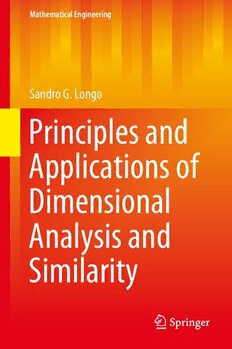Table Of ContentMathematical Engineering
Sandro G. Longo
Principles and
Applications of
Dimensional
Analysis and
Similarity
Mathematical Engineering
SeriesEditors
JörgSchröder,InstituteofMechanics,UniversityofDuisburg-Essen,Essen,
Germany
BernhardWeigand,InstituteofAerospaceThermodynamics,Universityof
Stuttgart,Stuttgart,Germany
Today,thedevelopmentofhigh-techsystemsisunthinkablewithoutmathematical
modeling and analysis of system behavior. As such, many fields in the modern
engineering sciences (e.g. control engineering, communications engineering,
mechanicalengineering,androbotics)callforsophisticatedmathematicalmethods
inordertosolvethetasksathand.
The series Mathematical Engineering presents new or heretofore little-known
methodstosupportengineersinfindingsuitableanswerstotheirquestions,presenting
thosemethodsinsuchmannerastomakethemideallycomprehensibleandapplicable
inpractice.
Therefore,theprimaryfocusis—withoutneglectingmathematicalaccuracy—on
comprehensibilityandreal-worldapplicability.
Tosubmitaproposalorrequestfurtherinformation,pleaseusethePDFProposal
Formorcontactdirectly:Dr.ThomasDitzinger(thomas.ditzinger@springer.com)
IndexedbySCOPUS,zbMATH,SCImago.
Moreinformationaboutthisseriesathttps://link.springer.com/bookseries/8445
Sandro G. Longo
Principles and Applications
of Dimensional Analysis
and Similarity
SandroG.Longo
DepartmentofEngineeringandArchitecture
UniversityofParma
Parma,Italy
ISSN2192-4732 ISSN2192-4740 (electronic)
MathematicalEngineering
ISBN978-3-030-79216-9 ISBN978-3-030-79217-6 (eBook)
https://doi.org/10.1007/978-3-030-79217-6
©TheEditor(s)(ifapplicable)andTheAuthor(s),underexclusivelicensetoSpringerNature
SwitzerlandAG2021
Thisworkissubjecttocopyright.AllrightsaresolelyandexclusivelylicensedbythePublisher,whether
thewholeorpartofthematerialisconcerned,specificallytherightsoftranslation,reprinting,reuse
ofillustrations,recitation,broadcasting,reproductiononmicrofilmsorinanyotherphysicalway,and
transmissionorinformationstorageandretrieval,electronicadaptation,computersoftware,orbysimilar
ordissimilarmethodologynowknownorhereafterdeveloped.
Theuseofgeneraldescriptivenames,registerednames,trademarks,servicemarks,etc.inthispublication
doesnotimply,evenintheabsenceofaspecificstatement,thatsuchnamesareexemptfromtherelevant
protectivelawsandregulationsandthereforefreeforgeneraluse.
Thepublisher,theauthorsandtheeditorsaresafetoassumethattheadviceandinformationinthisbook
arebelievedtobetrueandaccurateatthedateofpublication.Neitherthepublishernortheauthorsor
theeditorsgiveawarranty,expressedorimplied,withrespecttothematerialcontainedhereinorforany
errorsoromissionsthatmayhavebeenmade.Thepublisherremainsneutralwithregardtojurisdictional
claimsinpublishedmapsandinstitutionalaffiliations.
ThisSpringerimprintispublishedbytheregisteredcompanySpringerNatureSwitzerlandAG
Theregisteredcompanyaddressis:Gewerbestrasse11,6330Cham,Switzerland
TomyparentsVincenzoandGilda,
whohaveneverleftmealone
Preface
Dimensional analysis is a research tool that covers all research sectors. Much has
alreadybeenwrittentosurveythegeneralconceptsortodeepensomesubtleaspects,
anditisdifficulttoaddsomethingnewordifferent.Alistofthecontributionswould
inevitablybeincomplete.
Itisacommonopinionthatdimensionalanalysisallowsustoclarifyfactsalready
known and appears not very effective for the analysis of new processes and for
progress;seealsothecommentbyGibbings.1Itisworthwhiletorememberthatthe
search for greater clarity in the analysis of physical processes inevitably leads to
greater knowledge. The criteria of analogy between distinct processes, introduced
by dimensional analysis and then developed by the theory of similarity, are very
effectiveforimprovingtheaveragelevelofscientificarguments.
Thediscussionoftheprinciplesandapplicationsofdimensionalanalysisleaves
manyquestionsonrelevantissuesstillunanswered,althoughthediscussionsonthe
fundamentals are commonly neglected while taking care of the more applicative
aspects.Forexample,thequestionofthenumberandnatureoffundamentaldimen-
sions,aswellasthevalidityofreducingtheirnumberonthebasisofnewphysical
relationshipsoroftheirincreasebydiscriminatingthembygivingdifferentrolesto
thesamedimension,isstillunanswered.Thisisnotatrivialmattersince,asdemon-
stratedinthebook,anincreaseinthenumberoffundamentalquantitiesleadstoa
reductioninthenumberofdimensionlessgroupsand,ultimately,toasimplification
ofthestructureofphysicalequations–allthisonlyonthebasisofchoicesunjustified
and not justifiable a priori. This is one of the reservations and is perhaps the most
relevant. However, weremind ourselves thatclassicalmechanics isbased onprin-
ciplesandaxioms(homogeneityandisotropyofthespace;stationarity;seeLandau
&Lifshitz19782),assumedtobethebasisofacompletetheorythat,ultimately,has
undergoneexperimentalvalidation.
1J.C.Gibbings.(1980).Ondimensionalanalysis.JournalofPhysicsA:MathematicalandGeneral
13(1),75.
2L. D. Landau & E. M. Lifshitz. (1960). Course of Theoretical Physics (Vol. 1: Mechanics).
PergamonPress.
vii
viii Preface
Practicallynonexistentarereservationsonthetheoryofsimilarityandmodels,the
secondimportanttopicdiscussedhere.Currentthinkingonthescientificrepresenta-
tionofrealityassumesthattheresourcesusefulforsuchrepresentationarelinguistic,
considering mathematics as a specific language (Giere 20043): the language of
science has its own syntax, a semantic aspect and a pragmatic one. In physical
modelling,itisthepragmaticaspectthatisemphasised,withsyntaxandsemantic
aspectsadaptedaccordingly.
Leaving aside the issues of foundation, which are here only briefly mentioned,
thepurposeofthebookistoprovidethenecessaryandappropriatetoolsforanaccu-
rateandconsistentinterpretationofphysicalprocesses,boththroughmathematical
analysisandthroughphysicalmodelling.Thefirstchaptersaddressthedefinitions,
with few dimensional analysis theorems and similarity criteria. There is also the
analysisofself-similarity,bothoffirstandsecondkind,withacoupleofcompletely
solvedproblems,framedwithinthegrouptheory.Ihavedeliberatelynotdealtwith
thetheoryofrenormalisedgroups,whichIconsidermorespecialised.
From Chap. 5 onward, the focus is on applications in some of the engineering
sectors. The number of topics is necessarily limited, but, almost always, there are
details, calculations and treatment of assumptions. To avoid making the book too
broad,Ihaveleftoutthedescriptionofmanyexperimentaldevicesusedforphysical
modelling, such as channels and tanks with wave generators and rotary platforms
forgeophysicalmodels.Ihaveincludedonlyabriefdescriptionofthecentrifugeof
theshakingtable,althoughanentirechapterisdevotedtowindtunneltechnology.
I have also omitted the treatment of measurement techniques and instrumentation,
available, for example, in Doebelin, 20084 and in several other books focused on
differentbranchesofresearch.Somemorespecificnotions,requiredbythecontext,
arereportedintheAppendix,whereappearsalsothedescriptionofnumerousdimen-
sionless groups, all of engineering interest, but with the exclusion of many others
relatedtophysicalprocessesofelectricalnatureorphysicsofparticles.Ipreferto
repeatedlyexplainthesymbolsnexttotheformulasthatusethem,ratherthanlisting
them in an Appendix. As far as I could, I tried to make them uniform: a specific
symbolcorrespondstothesamevariablethroughoutthebook.Theglossaryliststhe
meaningofsomespecifictermsusedinthebook.
Thebookisaddressedtothosetrainedinengineeringdisciplinesandnaturaland
physical sciences and to graduate students and fellow researchers interested in a
clarification of the methodology, of dimensional analysis and theory of similarity
aimsandpurposes.
Muchoftheworkinvolvedinwritingthisbookwasdoneduringmystayonsabbat-
icalleaveinGranada,Spain,intheSpring-Summerof2010,hostedbyProf.Miguel
A. Losada, Emeritus of the University of Granada and at that time Director of the
CentroAndaluzdeMedioAmbiente(CEAMA),ajointresearchstructurebetween
the Junta de Andalucia and the Universidad de Granada. At CEAMA, in addition
3R.N.Giere.(2004).Howmodelsareusedtorepresentreality,PhilosophyofScience,71,742–
752.
4E.O.Doebelin.(1990).Measurementsystems:Applicationanddesign.McGraw-HillBookCo.
Preface ix
to the availability of the laboratory and all the equipment to carry out my experi-
mentalresearchprogram,co-monitoredbyLucaChiapponi,MaraTonelli,Simona
BramatoandChristianMans,Ihadthecompleteavailabilityofwhatwasnecessary
forbibliographicinvestigationsandtomeditateandtowrite.Ihadafantastictime
inGranada,wherenumerousyoungresearchersandstudentsweredeeplyinvolved
inwindtunnelandseagravitywavesandrelatedphenomenaresearch.
The English language version, revised and extended with new sections, was
completed during the COVID-19 pandemic in 2020, which is about to be finally
eradicatedthankstobiomedicalresearch,withseveralvaccinesbeingdevelopedvery
quickly.Thanksareduetoalltheresearchersinvolvedinthatfieldandinmemory
ofthosewhodidnotsurvive.
Parma,Italy SandroG.Longo
April2021
Acknowledgements
Muchoftheexpertiseacquiredpriortothedraftingofthismonograph,istheresultof
decadesofscientificcollaborationwithMiguelA.Losada,EmeritusoftheUniversity
ofGranada(Spain),MariusUngarish,EmeritusofTechnion(Israel),andVittorioDi
Federico,FullProfessorattheUniversityofBologna(Italy).Iwouldliketothank
them and their research groups for sharing their knowledge on some fascinating
phenomenaofFluidMechanics.
Igratefullyacknowledgecriticalreadingofsomechaptersbycolleagues;Andrea
Maranzoni critically commented on Chap. 3, Andrea Spagnoli commented on
Chap. 7, and Diana Petrolo revised and commented on all the chapters. I thank
LucaChiapponi,whocreatedsomeofthemostcomplexfigureswithgreataccuracy.
xi

